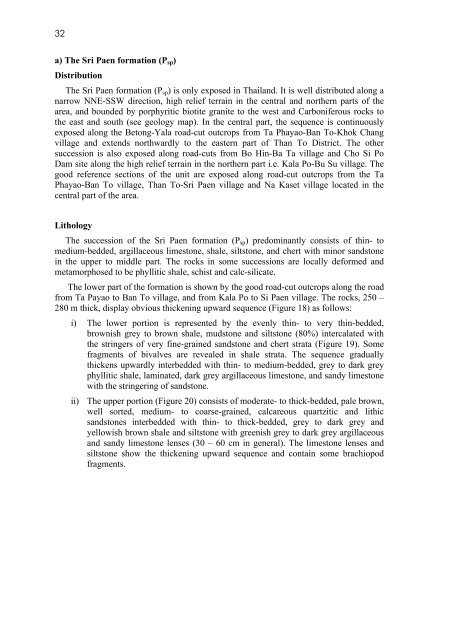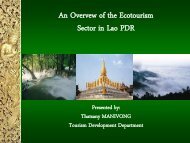GEOLOGY OF THE PENGKALAN HULU-BETONG TRANSECT ...
GEOLOGY OF THE PENGKALAN HULU-BETONG TRANSECT ...
GEOLOGY OF THE PENGKALAN HULU-BETONG TRANSECT ...
Create successful ePaper yourself
Turn your PDF publications into a flip-book with our unique Google optimized e-Paper software.
32<br />
a) The Sri Paen formation (Psp)<br />
Distribution<br />
The Sri Paen formation (Psp) is only exposed in Thailand. It is well distributed along a<br />
narrow NNE-SSW direction, high relief terrain in the central and northern parts of the<br />
area, and bounded by porphyritic biotite granite to the west and Carboniferous rocks to<br />
the east and south (see geology map). In the central part, the sequence is continuously<br />
exposed along the Betong-Yala road-cut outcrops from Ta Phayao-Ban To-Khok Chang<br />
village and extends northwardly to the eastern part of Than To District. The other<br />
succession is also exposed along road-cuts from Bo Hin-Ba Ta village and Cho Si Po<br />
Dam site along the high relief terrain in the northern part i.e. Kala Po-Bu Su village. The<br />
good reference sections of the unit are exposed along road-cut outcrops from the Ta<br />
Phayao-Ban To village, Than To-Sri Paen village and Na Kaset village located in the<br />
central part of the area.<br />
Lithology<br />
The succession of the Sri Paen formation (Psp) predominantly consists of thin- to<br />
medium-bedded, argillaceous limestone, shale, siltstone, and chert with minor sandstone<br />
in the upper to middle part. The rocks in some successions are locally deformed and<br />
metamorphosed to be phyllitic shale, schist and calc-silicate.<br />
The lower part of the formation is shown by the good road-cut outcrops along the road<br />
from Ta Payao to Ban To village, and from Kala Po to Si Paen village. The rocks, 250 –<br />
280 m thick, display obvious thickening upward sequence (Figure 18) as follows:<br />
i) The lower portion is represented by the evenly thin- to very thin-bedded,<br />
brownish grey to brown shale, mudstone and siltstone (80%) intercalated with<br />
the stringers of very fine-grained sandstone and chert strata (Figure 19). Some<br />
fragments of bivalves are revealed in shale strata. The sequence gradually<br />
thickens upwardly interbedded with thin- to medium-bedded, grey to dark grey<br />
phyllitic shale, laminated, dark grey argillaceous limestone, and sandy limestone<br />
with the stringering of sandstone.<br />
ii) The upper portion (Figure 20) consists of moderate- to thick-bedded, pale brown,<br />
well sorted, medium- to coarse-grained, calcareous quartzitic and lithic<br />
sandstones interbedded with thin- to thick-bedded, grey to dark grey and<br />
yellowish brown shale and siltstone with greenish grey to dark grey argillaceous<br />
and sandy limestone lenses (30 – 60 cm in general). The limestone lenses and<br />
siltstone show the thickening upward sequence and contain some brachiopod<br />
fragments.



